Pros
Cons
Introduction
Product Overview
{{section_header}}{{section.name}}{{/section_header}}
Attractive for earbuds, the MM80is will offer you improved performance and functionality for iPhone users.
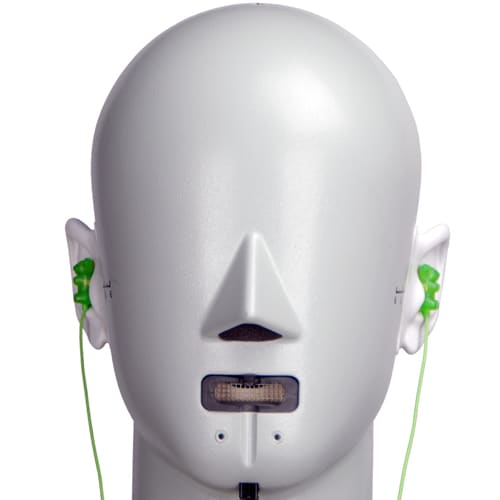
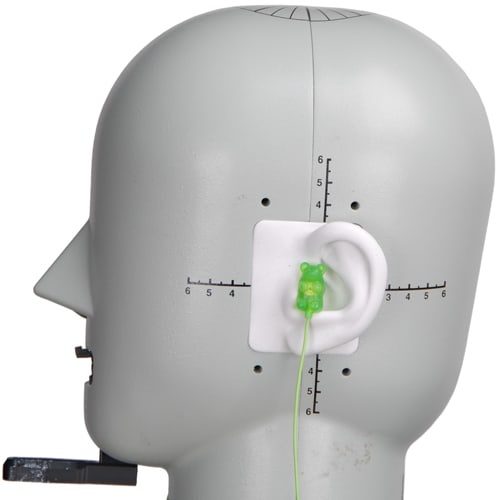
Speakers
{{section_header}}{{section.name}}{{/section_header}}
The somewhat large nozzles of the Sennheiser MM80is are guarded by a fine mesh that offer fairly good protection for the internal speaker elements.
Sides
{{section_header}}{{section.name}}{{/section_header}}
Back
{{section_header}}{{section.name}}{{/section_header}}
The backs of the MM80is prominently display the Sennheiser logo on a field of brushed metal.
Band
{{section_header}}{{section.name}}{{/section_header}}
Cable
{{section_header}}{{section.name}}{{/section_header}}
The cable of the MM80is is a standard 3.93 foot-long cord with an in-line remote and microphone element.
The MM80is end in a regular old 1/8th inch jack.
There really aren't much in the way of cord guards on the Sennheiser MM80is, which can be a bit of a durability concern, as the wires are the most likely part of the headphones to break, especially at solder points. The cord guards on the in-line remote are seemingly the most robust on the entire unit.
Additional Features
{{section_header}}{{section.name}}{{/section_header}}
The MM80is come packaged with a pair of clip-on earloops for your pinnae.
Also included is an airplane adapter, to prevent airline robbery for subpar headphones and a subpar movie.
In the Box
{{section_header}}{{section.name}}{{/section_header}}
The Sennheiser MM80is come packaged with three sizes of two different types of sleeves each, optional ear loops, a carrying case, a cleaning tool and an airplane adapter.
Durability
{{section_header}}{{section.name}}{{/section_header}}
Aside from being small plastic earbuds at the ends of the not-very-robust cords, there really isn't a whole lot keeping these earbuds from breaking. They're definitely not chintzy by any stretch of the imagination, but be careful not to break the cords because you will not be able to replace them. Other than that, these are a fairly solid pair of in-ears in terms of durability.
Aesthetics
{{section_header}}{{section.name}}{{/section_header}}
These little buds are certainly nifty-looking with their brushed metal appearance, but other than that they aren't much to look at. Earbuds aren't typically going to catch anyone's eye, so it's not surprising.
Frequency Response
{{section_header}}{{section.name}}{{/section_header}}
The frequency response of the MM80is is a bit... odd. For headphones that are supposed to be higher-end in-ears, they certainly don't seem to deliver in this area. The MM80is boost bass to a somewhat silly level, while dampening mid tones from 2-5kHz. After about 6kHz, there's a large spike in frequency dB from 7-8.5 kHz. Should there ever be a sound close to fingernails on a chalkboard, it will be boosted to an absurd volume in relation to your music. After this peak, the frequency response chart reads like a seismograph.
We would be remiss if we didn't point out that the sound of the MM80is seemed to be a bit muffled, and the complaint came from more than one person in the office. While we don't have a reliable, objective clarity test (yet), you may find that your music will not sound as great or as clear as you think it should.

Click here for more information on our frequency response test.
Distortion
{{section_header}}{{section.name}}{{/section_header}}
The MM80is showed only a small amount of distortion.
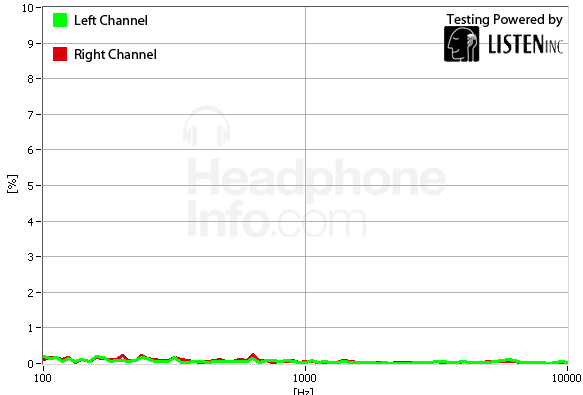
Click here for more information on our frequency response test.
Tracking
{{section_header}}{{section.name}}{{/section_header}}
The MM80is actually had a pretty even tracking response, even though there were some slight shifts here and there. Considering there was no shift greater than 2dB, we don't believe you will find much of a problem with these in-ears.
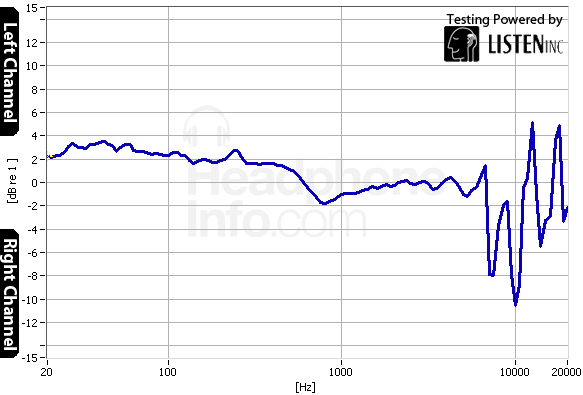
Click here for more information on our frequency response test.
Isolation
{{section_header}}{{section.name}}{{/section_header}}
Though the MM80is don't have active noise cancellation, they do an average job of blocking out external sounds. They don't really block out many lower frequencies though.

Click here for more information on our isolation test.
Leakage
{{section_header}}{{section.name}}{{/section_header}}
In-ears are typically great at keeping their sound in your ears and not broadcast to everyone else on the subway, and the MM80is are no different. The MM80is may not block out the most sound, but they do a great job preventing the outside world from hearing your guilty pleasures.
Click here for more information on our leakage test.
Maximum Usable Volume
{{section_header}}{{section.name}}{{/section_header}}
Like we've done in the past, we're going to preface this section with a warning: please don't listen to your headphones at a level at or above 120 decibels. This is the level that can damage your hearing permanently, and we believe that you're probably going to want to listen to your music for many years to come, so protecting your hearing is very important.
The MM80is were able to exceed 120dB before hitting the magic 3% distortion mark. Chances are good that you won't need to drown out a jet engine with these earbuds, so this performance will probably see no practical application in your listening experience.
Click here for more on our maximum usable volume test
Short-Term Use
{{section_header}}{{section.name}}{{/section_header}}
In the short term, the MM80is were fairly comfortable for a set of in-ears, but beware: it's not often that this type of headphone feels comfortable, as they are essentially pieces of plastic and rubber jammed deep into your ear canal. We feel that these will never really be as comfortable as on or over-ears, but we advise readers to try before they buy.

Extended Use
{{section_header}}{{section.name}}{{/section_header}}
Over time, the MM80is didn't get any more or less comfortable, but they're still in-ears, so the score remains similarly low. Over time, you'll begin to notice that these in-ears have a major amount of cable noise. While it's not distracting in the short term if you're sitting down, it will be extremely annoying if you're out for a walk or moving around a lot, you'll notice a bunch of extra noise being generated simply by moving.
Customizability
{{section_header}}{{section.name}}{{/section_header}}
There are a myriad of ways that you can customize the MM80is with the three sizes of two different types of sleeves, as well as the detachable remote and the plastic earloops. These are a pair of headphones that definitely give you the options you need to make your listening experience a comfortable one.
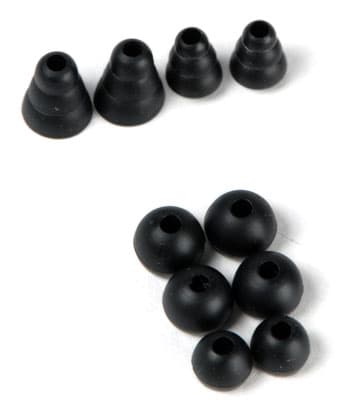
Cable Connectivity
{{section_header}}{{section.name}}{{/section_header}}
The Sennheiser MM80is have a fairly standard cord length of 3.93 feet, and an remote that can be removed by unplugging the headphones. Be aware that if you do this, your cable length drops to about a foot, maybe a little more.
Portability
{{section_header}}{{section.name}}{{/section_header}}
In-ears are extremely portable to begin with, but the MM80is are very easy to carry around and forget you have them. Not only are they very light and small, allowing you to jam them into your pockets, but they come with a nifty carrying case that corrals the cords with a guide on the inside of the case.
Maintenance
{{section_header}}{{section.name}}{{/section_header}}
Included with the MM80is is a cleaning tool to scrape the screens guarding the nozzles. if you are the kind of person that has to worry about bio waste building up in your in-ears, have no fear.
Other Features
{{section_header}}{{section.name}}{{/section_header}}
Remote & Mic
Compatible with most iOS devices, the remote/mic is located just beyond the cable split. This unit carries a small surprise, as you can unplug the cable from this device, leaving you with a pair of headphones with a cable that might only be a foot long. Still, the option to remove the remote is available, should you care about that sort of thing.
Design
{{section_header}}{{section.name}}{{/section_header}}
Both Sennheisers, these in-ears have somewhat similar designs, especially with the somewhat wide nozzle. If you're looking for longevity from your earbuds, however, the IE 8is are going to appeal more to you. They were designed around being able to replace broken cables by having removable earbuds, and really, this is a great feature to have with in-ears, as the cables are the most likely thing to break.
Frequency Response
{{section_header}}{{section.name}}{{/section_header}}
As you can see from the comparison graphs below, there really wasn't a gigantic difference in frequency response between the two headphones: both had very emphasized bass, an inexplicable peak in the range home to nails across a chalkboard, and values beyond 10kHz reading like a seismograph.
Distortion
{{section_header}}{{section.name}}{{/section_header}}
Neither the IE 8is nor the MM80is had any significant troubles with distortion.
Tracking
{{section_header}}{{section.name}}{{/section_header}}
Surprisingly enough, the MM80is are the victor here, as their tracking never favored one channel more than the other by more than 2dB at any point, whereas the IE 8is have a bizarre cut to the right channel just below 7kHz.
Isolation
{{section_header}}{{section.name}}{{/section_header}}
The IE 8is and the MM80is have virtually the same level and distribution of frequencies isolated, but the MM80is seem to block out 5dB more across the entire range of audible frequencies.
Comfort
{{section_header}}{{section.name}}{{/section_header}}
Both units are very comfortable as far as in-ears go, and have virtually the same sleeves. Really, you're not going to notice much of a difference between these two headphones should you try them on.
Verdict
{{section_header}}{{section.name}}{{/section_header}}
In the end, what's important to you in a pair of headphones isn't something that we can scientifically measure, so you'll have to make your own decisions for yourself. You should note, however, that this one really comes down to durability: if you want to be able to replace your cables and keep your earbuds around for a few years, the IE 8is are a better pick. If this is less important to you, you can get roughly the same performance of the IE 8is in the MM80is for about half the price.
Design
{{section_header}}{{section.name}}{{/section_header}}
Since both of these in-ears don't really have many design elements centered around durability, this one comes down to a purely aesthetic contest, which we believe the mc5s win handily, as they simply look better.
Frequency Response
{{section_header}}{{section.name}}{{/section_header}}
It's worth noting that in our review of the mc5s, we found that they have a disproportionately high audio performance for their price range, and this comparison is no contest: the mc5s have a very even frequency response, and they don't overemphasize the bass frequencies. They don't have the same giant peak in the 5-7kHz range, and they tend to stay within our ideal response much better than the MM80is.
Distortion
{{section_header}}{{section.name}}{{/section_header}}
Neither set of in-ears had much in the way of distortion, but the mc5s technically had less.
Tracking
{{section_header}}{{section.name}}{{/section_header}}
Yes, we're splitting hairs on this one, but while the mc5s and the MM80is had very good tracking responses, the mc5s had about half of the measured tracking shift than the MM80is.
Isolation
{{section_header}}{{section.name}}{{/section_header}}
Another clear victory for the mc5s, they isolate a much greater amount of sound than the MM80is. Depending on your environment, this may or may not be a good thing, as it's possible to forget your surroundings if you aren't paying attention. We'd rather not have to break out the Headphones ATTACK!! images.
Comfort
{{section_header}}{{section.name}}{{/section_header}}
Since we have both the mc5s and the MM80is on hand here at HeadphoneInfo.com, we can tell you on good authority that the MM80is are immensely more comfortable than the mc5s. It's no secret that we're not the biggest fans of how in-ears feel, but the MM80is at least don't give your ear canals the sensation of being pressurized and sealed airtight.
Verdict
{{section_header}}{{section.name}}{{/section_header}}
While both in-ears are relatively good, if you want audio performance and supreme isolation, the mc5s are the better buy at less than half the cost of the MM80is. If you want your earbuds to be comfortable while offering decent audio performance and the ability to use them with your iOS device, stick with the MM80is.
Design
{{section_header}}{{section.name}}{{/section_header}}
Because the Apple iPod earbuds suffer from their ubiquity, it's not surprising that by now, if you were to see one person with the iPod earbuds and another with the Sennheiser MM80is, you'd probably think that the MM80is were a bit more attractive with their brushed metal design. While it's true that at one point the iPod headphones were iconic, in 2011 they are just boring. Both sets of earbuds have similar functionality and portability, so iPhone users can sleep easy knowing that their choice between these headphones will not greatly affect their use. It's also worth noting that the iPhone earbuds are not in-ears, but they precariously rest outside your ear canal behind your tragus and anti-tragus. This will have performance implications not shared by the MM80is later on.
Frequency Response
{{section_header}}{{section.name}}{{/section_header}}
This comes as quite a surprise, but the response of the iPhone earbugs technically had a much better response than the MM80is, as it was much more even. Still, if you like bass response, or think that some of the treble frequencies deserve to be boosted at all, you're probably going to want the MM80is.
Distortion
{{section_header}}{{section.name}}{{/section_header}}
No surprises here: the cheap iPhone headphones really can't be expected to compare to a much higher-quality set of in-ears, but it's worth showing you what kind of an upgrade you get from buying the Sennheiser MM80is over the stock earbuds. As you can see from the comparison graphs below, the iPhone earbuds have a massive amount of distortion in the lower frequencies, where the MM80is don't have much at all.
Tracking
{{section_header}}{{section.name}}{{/section_header}}
The MM80is have a much more even tracking response than the iPhone earbuds, only recording a maximum channel shift of 2dB.
Isolation
{{section_header}}{{section.name}}{{/section_header}}
Due in part to the very nature of their design differences, the MM80is isolate their sound far, far better than the iPhone earbuds. This isn't surprising, as it's a very good assumption that just about anything will isolate sound better than the iPhone earbuds, as they don't seem to block any outside noise at all.
Comfort
{{section_header}}{{section.name}}{{/section_header}}
This one goes to the MM80is as well, as it's not terribly comfortable to have to continuously re-adjust ill-fitting earbuds over and over again. While we're not crazy about how in-ears feel overall, the MM80is are much more secure in your ears, as they rest in your ear canal, and the wire over your pinna. The included sleeves aren't too uncomfortable either, so this one is a clear victory for the MM80is
Verdict
{{section_header}}{{section.name}}{{/section_header}}
This one seems to come down to cost, as the included iPhone 3G S headphones come free with the phone. Still, if you're looking to make the most of your iPhone experience, investing in a set of headphones that are capable of working with your iOS device and provide a much better audio performance and comfort level might be worth the extra cash. Still, the sting from paying for a smartphone like the iPhone will probably be fresh in your mind, so it's not unreasonable to postulate that you may not want to shell out $200+ more right away.
Design
{{section_header}}{{section.name}}{{/section_header}}
It goes without saying that the Beyerdynamic DTX 300 ps are quite different in design than the Sennheiser MM80is, being on-ear headphones, but with the design difference comes certain advantages and disadvantages that you may want to consider. Despite all that, if you're going for looks, you are much more likely to get noticed in the DTX 300 ps, and be satisfied with their durability a bit more, as they aren't simply small bits of plastic at the end of a cord, but rather they are small bits of plastic, leather and metal at the end of a cord.
Frequency Response
{{section_header}}{{section.name}}{{/section_header}}
The Beyerdynamic DTX 300 ps don't have the greatest frequency response, but it does maintain a decently level response until reading like a seismograph. On the other hand, the MM80is have a much more stable response, even if they overemphasize bass quite a bit.
Distortion
{{section_header}}{{section.name}}{{/section_header}}
Even though neither set of headphones tortured our headphone-testing robot HATS with egregiously bad distortion, the DTX 300 ps did give us about a 1% level in many spots throughout the range of audible frequencies, so audiophiles may avoid these headphones because of this. Still, your average listener will not really notice any difference, so don't put too much stock into this one.
Tracking
{{section_header}}{{section.name}}{{/section_header}}
This is another area in which the MM80is are clearly superior, as their tracking was very, very even compared to that of the DTX 300 ps.
Isolation
{{section_header}}{{section.name}}{{/section_header}}
By the very nature of their design, the in-ear MM80is block out much more sound than the DTX 300 ps, but both headphones seem to corral their own sound in an acceptable way.
Comfort
{{section_header}}{{section.name}}{{/section_header}}
Even though the plucky little DTX 300 ps have been smacked around in this comparison so far, the area in which they truly shine is comfort. It takes a little getting used to when you first put them on, but after a short while their soft fake leather and ultra-light design can make it easy to forget that you are wearing them at all. With the MM80is, you're jamming small pieces of plastic into your ear canals, so even if they're more comfortable than, say, the mc5s, they're still never going to come close to feeling as good as the DTX 300 ps.
Verdict
{{section_header}}{{section.name}}{{/section_header}}
Each type of headphones has their advantages and drawbacks, and these two models are no different: if you want audio quality and portability, go with the MM80is. If you are more concerned with comfort, the DTX 300 ps are by far and away superior in that regard.
Conclusion
{{section_header}}{{section.name}}{{/section_header}}
While the MM80is aren't the best pair of headphones we've ever reviewed, they do offer a much-improved performance over the iPhone 3G S earbuds, which they were designed to compete with. Though you're not going to look like an Apple fanboy/girl if you wear them, you will be satisfied in knowing that you are wearing headphones that are much better than the stock earbuds included with the iPhone. As standalone headphones, though, there are definitely other pairs of in-ears that will perform better, but for what they are, they aren't bad.
Meet the tester
A seasoned writer and professional photographer, Chris reviews cameras, headphones, smartphones, laptops, and lenses. Educated in Political Science and Linguistics, Chris can often be found building a robot army, snowboarding, or getting ink.
Checking our work.
Our team is here to help you buy the best stuff and love what you own. Our writers, editors, and experts obsess over the products we cover to make sure you're confident and satisfied. Have a different opinion about something we recommend? Email us and we'll compare notes.
Shoot us an email